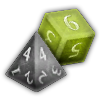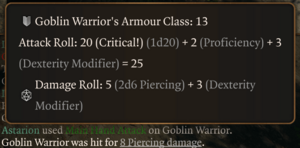Damage: Difference between revisions
(→A bit of mathematics: Added necessary context to avoid misleading readers into mistakenly believing 1d8 is superior to 2d4.) |
|||
| Line 12: | Line 12: | ||
== Damage rolls == | == Damage rolls == | ||
{{Excerpt|Dice rolls|Attack rolls|subsections=yes|templates=SAI, InfoBlob, note}} | |||
Dice | |||
= | |||
=== Example === | === Example === | ||
Revision as of 20:44, 9 January 2024
Damage is a number that represents how deadly a threat is. When a creature takes damage, they subtract that amount of damage from their current amount of hit points.
Damage is dealt with attacks and other harmful actions, as well as by a variety of conditions.
Damage rolls
Creatures make attack rolls when they attack a target, usually with a weapon or a spell.
If the result of the attack roll is equal to or higher than the target's Armour Class (AC), the attack hits, and the attacker rolls for damage. If the result is lower than the target's AC, the attack misses.
Attack roll modifiers
Attack rolls are always made using an associated ability:
- Unarmed attacks, and attacks made with melee weapons and thrown weapons generally add the attacking creature's Strength modifier.
- If the weapon has the Finesse property, attacks with it add either the attacker's Strength or Dexterity modifier, whichever is higher.
- Unarmed attacks may use the attacker's Dexterity modifier if they have certain features like Dextrous Attacks from the Monk class.
- Attacks made with ranged weapons add the creature's Dexterity modifier.
- Spell attacks add the caster's spellcasting ability modifier, generally determined by their class.
If the attacker is proficient with the weapon they are wielding, or if the attack is a spell attack or unarmed attack, they also add their proficiency bonus.
Critical hits
When a creature rolls a natural 20 on an attack roll, the attack is a critical hit. Critical hits automatically land regardless of the target's AC, and the attacker also rolls twice the normal number of dice to determine damage dealt, including additional dice such as those from smites or combat maneuvers. Modifiers and bonuses – including the creature's relevant ability score modifier and proficiency bonus – are not doubled.
Some feats, class features, and items reduce the critical hit threshold by 1, allowing the creature to land critical hits by rolling either 19 or 20 on attack rolls. Multiple sources of this effect stack, allowing the critical hit threshold to go even lower than 19.
Armour Class
Armour Class (AC) is a measurement of how difficult a creature is to be hit by an attack. In order to successfully hit a creature, the results of an attack roll must be equal to or greater than the target's Armour Class. AC can be increased by equipping armour and shields, by selecting certain feats when leveling up, or utilizing certain spells.
Formula
The formula that determines AC when wearing Armour in the torso slot is:
- Torso armor AC + Dexterity modifier + shield bonus + other bonuses and penalties
The AC bonus from Dexterity is typically capped at +2 when wearing medium armour[note 1][note 2], and is reduced to zero when wearing heavy armour.
Most Shields grant +2 AC.
Other bonuses include things like the Defense fighting style, which grants +1 AC while wearing armor, and the Cloak of Protection, which grants +1 AC at all times. Bonuses to AC stack with each other.
Other formulas
Barkskin sets the affected creature's AC to 16 if they would otherwise have less.
Unarmoured creatures may use a different formula if they have certain features. Creatures always use whichever formula they have access to that would result in the highest AC. Alternative formulas are only used if no items marked "Light Armor", "Medium Armor", or "Heavy Armor" are being worn in any equipment slot.
and :
- 13 + Dexterity modifier + shield bonus + other bonuses and penalties
:
- 10 + Constitution modifier + Dexterity modifier + shield bonus + other bonuses and penalties
:
- 10 + Wisdom modifier + Dexterity modifier + other bonuses and penalties
Example
A successful attack with a ![]() Dagger does a base of 1d4
Dagger does a base of 1d4![]() Piercing damage (1~4). This means a single four-sided die
Piercing damage (1~4). This means a single four-sided die ![]() is rolled to determine the damage, for a total of 1 to 4 piercing damage. Most weapons use a single damage die, but some two-handed weapons use two: a successful attack with a
is rolled to determine the damage, for a total of 1 to 4 piercing damage. Most weapons use a single damage die, but some two-handed weapons use two: a successful attack with a ![]() Greatsword does 2d6
Greatsword does 2d6![]() Slashing damage (2~12), rolling two six-sided dice
Slashing damage (2~12), rolling two six-sided dice ![]() for a total of 2 to 12 slashing damage. Damaging spells typically roll more dice: for example, being caught in a will cause 8d6
for a total of 2 to 12 slashing damage. Damaging spells typically roll more dice: for example, being caught in a will cause 8d6![]() Fire damage (8~48), though a successful Saving Throw can reduce it to half.
Fire damage (8~48), though a successful Saving Throw can reduce it to half.
Damage types
All damage has a damage type, of which there are 13:
Bludgeoning, piercing and slashing damage are sometimes collectively referred to as Physical damage.
If a source of damage mixes different sizes of dice or damage types, they will be listed separately with a plus sign between them, e.g. 1d8![]() piercing + 1d4
piercing + 1d4![]() fire. Each type is dealt separately, though see damage mechanics for more details.
fire. Each type is dealt separately, though see damage mechanics for more details.
Resistance, Vulnerability and Immunity
A creature's resistances determine which damage types they are immune, resistant or vulnerable to:
- Damage dealt to a creature with resistance to that damage type is halved.
- Damage dealt to a creature with vulnerability to that damage type is doubled.
- Damage dealt to a creature with immunity to that damage type is reduced to zero.
Resistance and vulnerability to the same type cancel each other out, but don't affect immunity.
A bit of mathematics
Note that due to the mathematics of dice rolls, the difference between, say, 1d8 and 2d4 is more than just the higher minimum value of 2 on the 2d4 roll. With the d8, you have an equal chance of getting, say, a 5 and an 8. On the other hand, the 2d4 roll is statistically more likely to lead to a total value of 5, than a total value of 8. This is most easily explained with a table of all possible outcomes:
| First roll | Second roll | Total value |
|---|---|---|
| 1 | 1 | 2 |
| 1 | 2 | 3 |
| 1 | 3 | 4 |
| 1 | 4 | 5 |
| 2 | 1 | 3 |
| 2 | 2 | 4 |
| 2 | 3 | 5 |
| 2 | 4 | 6 |
| 3 | 1 | 4 |
| 3 | 2 | 5 |
| 3 | 3 | 6 |
| 3 | 4 | 7 |
| 4 | 1 | 5 |
| 4 | 2 | 6 |
| 4 | 3 | 7 |
| 4 | 4 | 8 |
Notice how often the 5 appears in the possibilities for the total value (4 out of 16 possibilities) vs. how often the 8 appears (1 out of 16). This means a 2d4 roll has a 25% chance of resulting in 5 points of damage, but only a 6.125% chance of resulting in 8 points of damage. Meanwhile, the 1d8 roll actually has a higher chance of resulting in the maximum damage value of 8, since 1 out of 8 possibilities (12.5%) result in an 8. However, the average roll of 2d4 is 5 damage, while the average roll of is only 4.5, because 2d4 can never roll a 1. Therefore, 2d4 is generally more consistent in damage output and will result in higher rolls in the long run.
See also
Footnotes
- ↑ The Medium Armour Master feat increases the cap from +2 to +3.
- ↑ A few rare armours have an "Exotic Material" trait that allow the wearer to get the full Dexterity bonus to AC. These include Yuan-Ti Scale Mail, Unwanted Masterwork Scalemail, Sharpened Snare Cuirass, and Armour of Agility.

